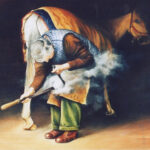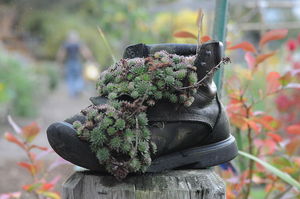Horses don’t get sick as often as other animals. However, a horse’s hooves are a breeding ground for most of the common horse diseases. The reason why is because horses spend most, if not all of their lives, standing and aren’t able to lie down for any length of time without getting sick. This is why horse shoes are very important, and taking care of your horse’s hooves and making sure they can withstand normal wear and tear is the most important part of horse care.
One of the most common problems in a horse’s hooves is white line disease. This disease attacks the part of the foot where the hoof actually meets the foot, the inner hoof wall. If left undetected, it’ll eventually cause the complete separation of the laminae and hoof wall and cause the coffin bone of the horse to rotate. It starts as a simple white line that may not look very serious, but as it deteriorates and eats away at the hoof, your horse will experience a great deal of pain. If you don’t catch it and treat it, your horse will go lame and you may be forced to put him down.
The actual disease is a bacteria and fungi combination that usually lives around the barn or pasture but really thrives in a non-oxygen environment, like a cracked hoof. Horses become more likely to contact the disease if their hooves are cracked, have chronic infections like abscesses, are unbalanced, or have suffered some major trauma. It doesn’t matter what horse breed you own: it affects all breeds and can be found in one or all four hooves.
The early signs of white line disease infestation are: a bulge shape in the hoof, a hollow sound when the hoof is tapped with a hammer, tender soles, and of course, a white line that’s soft and chalky. If your horse has lost a shoe and piece of hoof, that may also be a sign of infestation. To figure out what the best treatment is, you should consult a veterinarian and a farrier. They may need to x-ray the horse’s hoof to determine how extensive the damage is. The farrier will need access to these x-rays if s/he needs to shoe the horse therapeutically to support the weakened hoof wall.
The only way to stop it is by applying medicine (like bedatine, merthiolate, or two-percent iodine) and making sure your horse’s hooves are filed down to the point there they are no longer affected by it. If the disease has progressed, this might be even harder for you to do. One of the best ways you can prevent this is to follow the same path when preventing other common horse diseases: making sure your horse is living in a safe, warm, dry, and clean area where they don’t have to worry about bacteria.
Of course there are other common horse diseases, like colic, to which your horse may fall victim. Be a diligent owner who takes the time to make sure bacteria doesn’t have a chance to grown and infect your horse, and you and your horse will be enjoying many happy riding years together.







